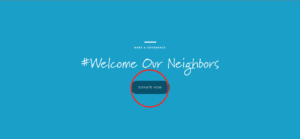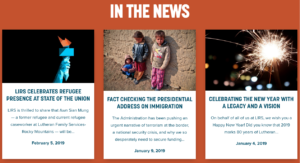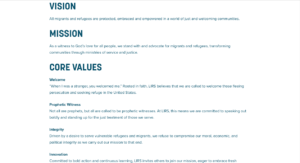Rhetorical analyses are conducted to allow the reader to understand the text and its intended messages. According to Writer/Designer: A Guide to Making Multimodal Projects, a rhetorical analysis is classically defined as “a method of describing the context in which an author wants to communicate his or her purpose or call for action to the intended audience in a genre” (Arola et al. 22). Many questions can be answered through the analysis, such as “why did the author compose this text?” and “what is the texts purpose?” The following rhetorical analysis will take a look at Lutheran Immigration and Refugee Service (LIRS) and analyze how the organization utilizes interface design to portray a cohesive message aurally, visually, spatially, gesturally, and linguistically. The visualizations not only tell the organizations story, but also work to encourage action, involvement and donation.

AUDIENCE
The LIRS identifies their primary audience through how the website is designed and where focus is placed. The website is organized spatially and places a large red button with the words “donate” within the top right-hand corner. This identifies the primary audience as donors or those looking to provide money. After clicking the button, a page appears that includes the heading “Say yes to helping families.” Under the heading is a donation form with a quote which states “your contribution helps” (“Lutheran,” 2019). The secondary audience can be identified through linguistics. The website provides information on how to volunteer or get involved in many spaces. In addition, the words “God” and “Faith’ are used continuously throughout the website. This means that LIRS secondary audience is volunteers who are Lutheran or religious. They appeal to this group by incorporating verbiage that appeals to their faith.

PURPOSE
The overall intention and purpose is to increase donations and physical volunteers. This is evident through the repetition of the words “donate” and “get involved” on almost every page. No matter what page is visited on the sight, there is always a “donate” button that is visible. The secondary purpose is to educate others. This can be seen through the ability to read stories under the “The Latest: In The News” panel on the home page. In addition, there is a “press room” page that provides insight into articles previously published with LIRS name in it.
Also, the visualizations located on the website clearly indicate the intended purpose. The visuals on the website include a consistent blue color theme. According to color psychology, blue is associated with peace, tranquility and reliability (Ciotti, 2016). This reinforces the mission that can be found under the “About Us” tab. Conveniently located as the first option on the toolbar, the “Mission & Vision” page discusses the mission as “a witness to God’s love for all people, we stand with and advocate for migrants and refugees, transforming communities through ministries of service and justice” (“Lutheran,” 2019). This purpose is also reinforced through the linguistics used on the web page. Terms such as “God” and “faith-based” are scattered throughout the website, showing that a secondary purpose is to work and educate through religion.
CONTEXT
The context in which the LIRS information can be access is through a website. It can be assumed that the reasoning behind this is because it is easy to access. In addition, websites are universal, customizable and can be shared online. This also provides a quick and easy way for those to donate online. The LIRS has taken advantage of the technological era that we live in and has manipulated the donation page to provide “preset amounts.” This means that suggested donations amounts are offered to sway donations. In addition, there are many cultural connotations within the text. The website provides insight through updated news stories. These stories provide a present day look into religion and immigration. The news stories and present-day photos allow the reader to see that the issue of immigration is a modern-day issue. The LIRS utilizes the gestural mode by asking the viewer to scroll up and down to receive all the information. The website pushes information that is easily accessible and can be reached by many.

AUTHOR
The website contains an “our leadership” page that provides information about the organization and those involved. Credibility is built by mentioning that all branches of the Lutheran church are represented on the board, as well as other denominations. It is also mentioned that there are three former refugees or immigrants on the board. The organization also shows credibility by listing their partners including resettlement, immigration and foster care partners. While the exact author of the website cannot be confirmed, the director of marketing and communications is Danielle Bernard. Individual information is not provided about this director, therefore her credibility cannot be confirmed or denied. The intention of the website was to display the organization as a whole, which explains the lack of individual information. The LIRS makes up for this in the credibility that they receive from their recourses, partners and press room.


GENRE
The genre this text is an informational resource. The organization is a non-profit, which means it is centered around educating, getting people involved and obtaining donations. Similar to other texts in the genre, the LIRS is a very informative and easy to navigate platform. The LIRS website is very comparable to other resources such as The Esperanza Center or The Maryland Immigration Rights Coalition. The websites all feature spaces to donate, volunteer and updated news archives.
CONCLUSION
The LIRS website utilizes its modes and affordances to provide an interesting and informative site. The visuals of the website allow for clear navigation and messaging. As a non-profit website, it provides a balance of information and call to action. The website could benefit from personal stories clearly placed on the website. The home page could benefit from a video to provide more aural and gestural support. Overall, the website was efficient in telling the organizations story through its modes.
REFERENCES
Arola, Sheppard, & Ball. Writer/Designer: A Guide to Making Multimodal Projects. Boston, Bedford/St. Martin’s, 2014.
Ciotti, Gregory. “The Psychology of Color in Marketing and Branding.” Entrepreneur, Entrepreneur, 13 Apr. 2016, www.entrepreneur.com/article/233843.
“Lutheran Immigration and Refugee Service.” LIRS, 6 Feb. 2019, www.lirs.org/.